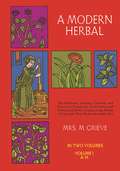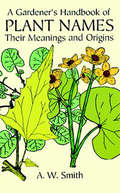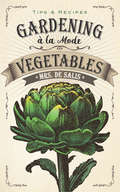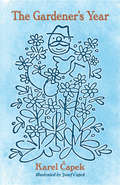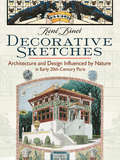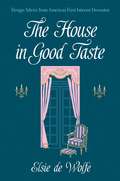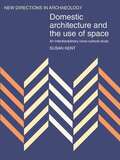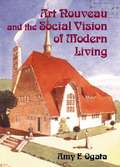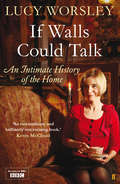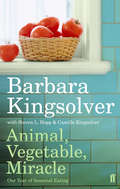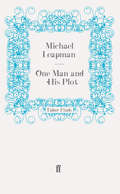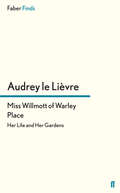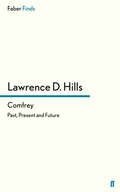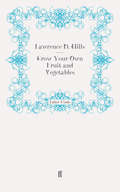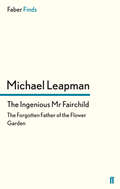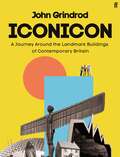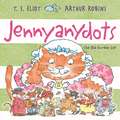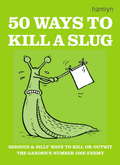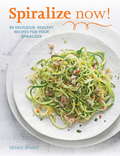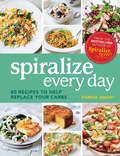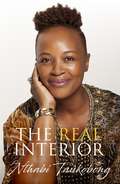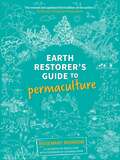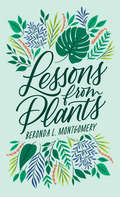- Table View
- List View
A Modern Herbal
by Margaret GrieveIf you want to know how pleurisy root, lungwort, and abscess root got their names, how poison ivy used to treat rheumatism, or how garlic guarded against the Bubonic Plague, consult A Modern Herbal. This 20th-century version of the medieval Herbal is as rich in scientific fact and folklore as its predecessors and is equally encyclopedic in coverage. From aconite to zedoary, not an herb, grass, fungus, shrub or tree is overlooked; and strange and wonderful discoveries about even the most common of plants await the reader.Traditionally, an herbal combined the folk beliefs and tales about plants, the medicinal properties (and parts used) of the herbs, and their botanical classification. But Mrs. Grieve has extended and enlarged the tradition; her coverage of asafetida, bearberry, broom, chamomile, chickweed, dandelion, dock, elecampane, almond, eyebright, fenugreek, moss, fern, figwort, gentian, Hart's tongue, indigo, acacia, jaborandi, kava kava, lavender, pimpernel, rhubarb, squill, sage, thyme, sarsaparilla, unicorn root, valerian, woundwort, yew, etc. — more than 800 varieties in all — includes in addition methods of cultivation; the chemical constituents, dosages, and preparations of extracts and tinctures, unknown to earlier herbalists; possible economic and cosmetic properties, and detailed illustrations, from root to bud, of 161 plants.Of the many exceptional plants covered in Herbal, perhaps the most fascinating are the poisonous varieties — hemlock, poison oak, aconite, etc. — whose poisons, in certain cases, serve medical purposes and whose antidotes (if known) are given in detail. And of the many unique features, perhaps the most interesting are the hundreds of recipes and instructions for making ointments, lotions, sauces, wines, and fruit brandies like bilberry and carrot jam, elderberry and mint vinegar, sagina sauce, and cucumber lotion for sunburn; and the hundreds of prescriptions for tonics and liniments for bronchitis, arthritis, dropsy, jaundice, nervous tension, skin disease, and other ailments. 96 plates, 161 illustrations.
5000 Designs and Motifs from India
by Ajit MookerjeeIncredibly rich treasury of authentic royalty-free designs adapted from artifacts of the Harappa culture, coins and pottery from South India, Ajanta and Bagh murals, Muslim monuments, Buddhist temples, textiles from Gujarat, Punjab, other regions, masks and tribal arts, much more. Immediately usable material or great resource for design inspiration. Introduction. Notes.
A Gardener's Handbook of Plant Names: Their Meanings and Origins
by A. W. SmithFirst compact dictionary to combine definitions of botanical names in general usage with information on their derivation and guides to pronunciation. A monumental index provides a cross-reference from some 1,800 common plant names to corresponding botanical ones. Combines thoroughness, botanical rigor, and interesting facts and lore — all leavened with touches of humor.
Gardening à la Mode: Vegetables
by Harriet Anne De SalisWhat's the best way to protect vegetables from frost? How do you dry herbs and banish slugs? There's much to learn about making the most of your backyard vegetable garden, and this handy little guide is brimming with advice for novice gardeners. Written by a popular magazine columnist of the nineteenth century, these timeless suggestions offer straightforward guidance for every step of the way, from planting, watering, and fertilizing to cooking and preserving your homegrown produce.Author Harriet Anne de Salis was an expert at counseling Victorian housewives on the domestic arts, writing commonsense manuals for everything from cooking on a budget to raising poultry and training dogs. This companion volume to Gardening à la Mode: Fruits features alphabetized entries and an index for easy reference. Even seasoned gardeners and cooks are likely to find it a source of useful hints and enduring charm.
The Gardener's Year (Modern Library Gardening Ser.)
by Karel Capek Josef CapekThe creator of this book is best known internationally as the author of R.U.R., the science-fiction play that introduced the term "robot" to the world. Karel Čapek's satiric gifts take a different turn in this impishly comic book, which recounts the trials, labors, joys, and meditations of the amateur gardener.Rather than a how-to book, Čapek's volume offers a lighthearted mock-treatise on the pains and rewards of tending a small and resistant garden plot. From January to December, the author and his brother, illustrator Josef Čapek, trace the vagaries of the amateur horticulturist's year, with brief side notes on seeds, the soil, plants, the beauties of autumn, and other aspects of gardening. Fifty-nine delightful drawings complement this book, which will amuse readers with and without green thumbs.
Decorative Sketches: Architecture and Design Influenced by Nature in Early 20th-Century Paris
by René BinetAt the turn of the 20th century, artists and craftsmen throughout Europe and America were profoundly affected by a new art style that took its inspiration from nature. Generally referred to as Art Nouveau, the trend influenced all manner of creative types, from painters, illustrators, and architects to ironworkers, interior decorators, and designers of furniture and jewelry. Although broad and varied, the style is almost uniformly characterized by abstract, asymmetrical, curvilinear design. This "new art" both elevated the status of crafts to fine arts and brought objects into a harmonious relationship with their environment through the use of lines that were natural, vital, and, most importantly, organic.The decorative images in this volume, reproduced from a rare 1902 portfolio, reflect the era's exotic and imaginative approach to architecture and applied design. Sixty plates, 12 in full color and many with partial and varied color, exhibit the influence of the artwork of naturalist Ernst Haeckel on artist René Binet's designs, especially as related to Binet's "Monumental Door," prepared for the 1900 World's Fair in Paris. Illustrations reflecting the styles of Art Nouveau include a wealth of examples that range from doorbells and keys to stairways, fountains, jewelry, ceramics, and other items. Graphic designers, illustrators, architects, artists, and crafters will find this volume a rich source of ornamental ideas, authentic motifs, and design inspiration.
The House in Good Taste: Design Advice from America's First Interior Decorator (Dover Architecture)
by Elsie De Wolfe"Good taste can be developed in anyone, just as surely as good manners are possible to anyone. And good taste is as necessary as good manners," declared Elsie de Wolfe, the "first lady" of American interior design. Although de Wolfe decorated the homes of wealthy, socially prominent clients, she always maintained that her vision of elegant but comfortable living is attainable to all. This timeless 1913 book, written in a friendly, conversational tone, explains how to design, furnish, and decorate a house in order to make it a beautiful, useful, and livable home.De Wolfe pioneered the concept of the home as a representation of the owner's identity, and this book defines her decorating methods, philosophy, and approach to creating spaces for gracious entertaining. Part step-by-step manual and part aesthetic treatise, this volume advocates for simpler yet more refined decor. In contrast to the Victorian penchant for dark furniture, bric-a-brac, and heavy draperies, de Wolfe advised her readers to let in natural light, to replace gaudy colors with beige and ivory, and to abandon clutter. Her practical suggestions, illustrated by period photographs, illuminate the attitudes of a century ago while retaining their resonance for modern-day interior designers.
Domestic Architecture And The Use Of Space: An Interdisciplinary Cross-cultural Study (New Directions In Archaeology Ser.)
by Susan Kent Norman Yoffee Wendy Ashmore Francoise Audouze Cyprian Broodbank Tim Murray Colin Renfrew Nathan Schlanger Andrew Sherratt Timothy TaylorArt Nouveau And The Social Vision Of Modern Living: Belgian Artists In A European Context (Modern Architecture And Cultural Identity Ser.)
by Amy F. Ogata Richard A. EtlinArt Nouveau and the Social Vision of Modern Living considers the roles of primitivism and nationalism in Belgian Art Nouveau architecture and design.
If Walls Could Talk: An intimate history of the home
by Lucy WorsleyWhy did the flushing toilet take two centuries to catch on? Why did Samuel Pepys never give his mistresses an orgasm? Why did medieval people sleep sitting up? When were the two 'dirty centuries'? Why did gas lighting cause Victorian ladies to faint? Why, for centuries, did people fear fruit?All these questions - and more - are answered in this juicy, truly intimate history of the home.Through the bedroom, bathroom, living room and kitchen, Lucy Worsley explores what people actually did in bed, in the bath, at the table, and at the stove. From sauce-stirring to breast-feeding, teeth-cleaning to masturbation, getting dressed to getting married, this book will make you see your home with new eyes.
Animal, Vegetable, Miracle: Our Year of Seasonal Eating
by Barbara Kingsolver"We wanted to live in a place that could feed us: where rain falls, crops grow, and drinking water bubbles up right out of the ground."Barbara Kingsolver opens her home to us, as she and her family attempt a year of eating only local food, much of it from their own garden. Inspired by the flavours and culinary arts of a local food culture, they explore many a farmers market and diversified organic farms at home and across the country. With characteristic warmth, Kingsolver shows us how to put food back at the centre of the political and family agenda. Animal, Vegetable, Miracle is part memoir, part journalistic investigation, and is full of original recipes that celebrate healthy eating, sustainability and the pleasures of good food.
One Man and His Plot
by Michael LeapmanWriter of The Times Diary, Michael Leapman, became a tenant of an allotment next to Brixton Prison for 35p a year in 1974 when food and energy shortages inspired many people to attempt self-sufficiency. This book tells the story of the plot and the author's first year of cultivating it, written with humour and wit while providing a wealth of information for the would-be urban horticulturalist."It is splendid stuff and if your husband is a gardening bore and you want to shut him up for an hour or three, this is the answer.' The Guardian'It makes fine bedside reading, laced with plenty of anecdotes, good gardening information, plus an Idle Gardener's Almanac.' Good Housekeeping
Miss Willmott of Warley Place: Her Life and Her Gardens
by Dr. Audrey Le LievreBorn in 1858 to a wealthy family Ellen Willmott owned three gardens, in England, France and Italy, and employed one hundred and four gardeners. She mixed with royalty and her name was associated with the greatest gardeners of her time, Gertrude Jekyll, William Robinson and E. A. Bowles.In 1894 she joined the Royal Horticultural Society and in 1897 she was one of the first sixty recipients (and one of only two women) to receive the Victoria medal of honour. Warley Garden in Spring and Summer, a book of photographs, was published in 1909 and in 1912 she published The Genus Rosa. In the same year she was awarded the grande m�daille Geoffroi St Hilaire from the Soci�t� d'Acclimatation de France and in 1924 received the Dean Hole medal from the National Rose Society. An acknowledged and admired expert in her field Ellen Willmott died in 1934 aged 76, alone and nearly bankrupt. First published in 1980 this carefully researched biography is a fascinating account of a woman who was infamous in her time and whose mark can still be seen on the horticultural world today. Miss Willmott of Warley Place is republished to celebrate the 150th Anniversary of Ellen Willmott's birth.
Comfrey: Past, Present and Future (Conservation Gardening And Farming Ser. #Ser. C)
by Lawrence D. HillsComfrey is noted by both organic gardeners and herbalists for its great usefulness and versatility. Of particular interest is the 'Bocking 14' cultivar of Russian Comfrey. This strain was developed during the 1950s by Lawrence D. Hills, who founded the organic gardening organization now known as Garden Organic.Lawrence D. Hills was the world authority on comfrey. In this book, he wrote for farmers and gardeners in all countries, showing how this useful plant could be cultivated in both tropical and temperate zones to produce a crop equally rewarding for gardener, smallholder and mechanized farmer. Subtitled 'Past, Present and Future,' on its publication in 1976, this was the most comprehensive survey of the properties and cultivation of comfrey ever, and Comfrey remains undoubtedly the essential book on the subject, as well as a lasting testament to Lawrence D. Hills's indefatigable efforts to achieve a better understanding of it.
Grow Your Own Fruit and Vegetables
by Lawrence D. HillsGrow Your Own Fruit and Vegetables is Lawrence D. Hills's ground-breaking book on all aspects of fruit and vegetable growing. It was widely praised on its publication and remains a classic text in the world of organic gardening.'Its great merit is that one feels that every operation described has been personally carried out by the author and selected as the most satisfactory after due consideration of traditional methods. The treatment of each plant is described from start to finish with sense, relish and humour; there are many fascinating analyses of vitamin and mineral contents and nutritional values, of different vegetables and fruits; and there is excellent advice on picking, harvesting, as well as on cooking ... it is the best practical guide to the subject that has appeared for years, and the author is not concerned with argument or philosophy, only with growing produce well.' Country Life'There is no better guide to non-chemical gardening than Lawrence D. Hills ... He is exceptionally well read and a good practical gardener into the bargain, not a very common combination, and no doubt because of his wide-ranging knowledge he is more balanced in his views than some advocates of all-organic gardening ... Where I find Mr Hills most stimulating is in his highly personal approach to fruit and vegetable varieties and his recommendations based on such commercially unfashionable criteria as flavour and food value. There is a wealth of information here which would be difficult to find in any other single book.' A. G. L. Hellyer in the Financial Times
The Ingenious Mr Fairchild: The Forgotten Father of the Flower Garden
by Michael LeapmanBy the early eighteenth century botanists were inching towards the shocking truth that plants had male and female organs and reproduced sexually. The first person to realize the practical implications of this was London nurseryman and author Thomas Fairchild. By transferring the pollen of a sweet William into the pistil of a carnation, he created a new plant that became known as 'Fairchild's Mule': the first man-made hybrid in Europe. But this primitive form of genetic engineering aroused a scientific and religious furore.Michael Leapman offers fascinating and colourful detail about the life and times of Fairchild, a troubled, gentle soul whose pioneering work changed the course of horticulture and paved the way for the growth of gardening as a cultural obsession.'A beguiling perambulation around the Georgian nursery trade.' Sir Roy Strong, Daily Mail
Iconicon: A Journey Around the Landmark Buildings of Contemporary Britain
by John GrindrodA captivating exploration of Britain's most iconic contemporary buildings, from the Barratt home to the Millennium Dome.'A love letter to contemporary buildings and a fantastic account of recent British history, rich in humour.' NINA STIBBE'Brilliant, encyclopaedic, funny and often cutting.' DANNY DORLING'An eloquent, witty, passionate tour of Britain since the 1980s.' JOHN BOUGHTON'Recounts the stories of our lived landscapes with wit, passion and a shot of anger.' TOM DYCKHOFF'Grindrod has spoken to everyone and his observations are humane and acute.' OWEN HATHERLEYWimpey homes. Millennium monuments. Riverside flats. Wind farms. Spectacular skyscrapers. City centre apartments. Out of town malls.The buildings designed in our lifetimes encapsulate the dreams and aspirations of our culture, while also revealing the sobering realities. Whether modest or monumental, they offer a living history of Britain, symbols of the forces that have shaped our modern landscape and icons in their own right.ICONICON is an enthralling journey around the Britain we have created since 1980: the horrors and delights, the triumphs and failures. From space-age tower blocks to suburban business parks, and from postmodernist exuberance to Passivhaus eco-efficiency, this is at once a revelatory architectural grand tour and an endlessly witty and engaging piece of social history.
Jennyanydots: The Old Gumbie Cat (Old Possum's Cats)
by T. S. EliotI have a Gumbie Cat in mind, her name is Jennyanydots.Her coat is of the tabby kind, with tiger stripes and leopard spots.All day she sits upon the stair or on the steps or on the mat:She sits and sits and sits and sits - and that's what makes a Gumbie Cat!But the Old Gumbie Cat gets busy at the end of the day, teaching and cooking, and getting the mice, cockroaches and beetles organised!The sixth gorgeous Cats picture book with lively and colourful illustrations by Arthur Robins.
50 Ways to Kill a Slug: Serious And Silly Ways To Kill Or Outwit The Garden's Number One Enemy
by Sarah FordAre you being bullied by a mollusc that slimes all over your garden and munches through your favourite delphinium? Are you worried about using slug pellets for fear of endangering local wildlife? Take a stand against slugs with 50 alternative, organic, natural, chemical and humane solutions to slug problems. Trick, flick and frighten slugs out of your garden, leaving you with pest-free plants. Stop slugs in their tracks and make slimy trails a thing of the past.
Spiralize Now: 80 Delicious, Healthy Recipes for your Spiralizer
by Denise SmartThe must-have gadget for 2015, in minutes the spiralizer creates spaghetti, ribbons and spirals from your favourite vegetables. From courgetti (courgette spaghetti) to cunoodles (cucumber noodles), it is now easier than ever to create healthy twists to your favourite meals. Perfect for the health-conscious, these vegetables can become the star of your dish, replacing heavier ingredients such as pasta and rice, so that you can enjoy your meal while eating fewer calories and cutting back on refined carbohydrates.With recipes ranging from Thai beef salad and Crispy spiralized potato fries to Courgette and lemon drizzle cake and Apple tarte tatin, The Complete Spiralizer Cookbook will open your eyes to the true versatility of the spiralizer.
Spiralize Everyday: 80 recipes to help replace your carbs
by Denise SmartSpiralize, mash and rice your fruit and vegetables for a lighter alternative to pasta, bread, rice and more. Replace egg noodles with spiralized sweet potato, make a pizza with a courgette base, or snack on beetroot crisps instead of potato ones! With recipes for breakfasts, salads, light bites, mains, preserves, baking and desserts, Spiralize Everyday is the ultimate companion for all your spiralizing needs. It features 80 simple, tasty, low-carb recipes, including:Apple and blueberry buckwheat pancakesMoroccan beetroot tabbouleh with pomegranate and chickenMiso baked cod with daikon noodles and greensKimchiEasy pear, apple and ginger jamApple, cheese and walnut breadBeetroot and chocolate browniesSimple and fun, these recipes allow you to enjoy all your favourite treats in a new, healthier guise.
The Real Interior
by Nthabi Taukobong“In my own home is where my journey of healing began.” – NTHABI TAUKOBONGThe Real Interior not only allows the reader a behind-the-scenes peek into the glitz and glamour of design and décor, but into a career once never considered an option for a young girl, born in Soweto.As one of the first black and very recognisable faces of Interior Design in Africa, Nthabi Taukobong was thrust into the limelight from the very start of her profession. Spanning a career of more than 23 years she has worked on esteemed residential and leisure projects for presidents, African royalty, captains of industry and five-star hotels, to name but a few.Through the rough and often very challenging terrain of her chosen career, sprinkled generously with the high-end glamour of prestigious interiors that Nthabi has been privileged to work on, she learned that she, in fact, had to be seated right within her own interior before she could offer anything further to those in search of her creative gift.And as she searched and explored the greater world of design, trying to grasp what it really took to be an esteemed designer, the journey unexpectedly brought her right back into her own home. Not only Nthabi’s physical home, but also to her inner-home, the place that she refers to as her real interior.It was in writing a letter one evening, congratulating herself on reaching the milestone of 21 years in her career, that Nthabi discovered she was not only writing to herself, but to every creative.Her letter ended up being an entire book and Nthabi finally understood how her unique story could inspire and encourage others.
Earth Restorer's Guide to Permaculture (PDF): Revised And Expanded Edition
by Rosemary Morrow Rob AllsopEarth Restorer's Guide to Permaculture covers practical permaculture essentials such soils, water, microclimates, trees, seeds, design, pattern literacy, pests and weeds. New in this edition are discussions on air quality, marine permaculture, 'crowded margins' (including refugee camps), emerging economic models and livelihoods. As always, Rob Allsop's accessible illustrations complement and illuminate Rosemary Morrow's practical approach. As part of a growing call to action, Earth Restorer's Guide to Permaculture entreats and empowers us to launch a new restorative relationship with all life. The best gift to our world is a planet restored. Here is the guide to do just that!
Lessons from Plants
by Beronda L. MontgomeryAn exploration of how plant behavior and adaptation offer valuable insights for human thriving. We know that plants are important. They maintain the atmosphere by absorbing carbon dioxide and producing oxygen. They nourish other living organisms and supply psychological benefits to humans as well, improving our moods and beautifying the landscape around us. But plants don’t just passively provide. They also take action. Beronda L. Montgomery explores the vigorous, creative lives of organisms often treated as static and predictable. In fact, plants are masters of adaptation. They “know” what or who they are, and they use this knowledge to make a way in the world. Plants experience a kind of sensation that does not require eyes or ears. They distinguish kin, friend, and foe, and they are able to respond to ecological competition despite lacking the capacity of fight-or-flight. Plants are even capable of transformative behaviors that allow them to maximize their chances of survival in a dynamic and sometimes unfriendly environment. Lessons from Plants enters into the depth of botanic experience and shows how we might improve human society by better appreciating not just what plants give us but also how they achieve their own purposes. What would it mean to learn from these organisms, to become more aware of our environments and to adapt to our own worlds by calling on perception and awareness rather than reason? Montgomery’s meditative study puts before us a question with the power to reframe the way we live: What would a plant do?
The Gardens of Emily Dickinson
by Judith Farr Louise CarterIn this first substantial study of Emily Dickinson's devotion to flowers and gardening, Judith Farr seeks to join both poet and gardener in one creative personality. She casts new light on Dickinson's temperament, her aesthetic sensibility, and her vision of the relationship between art and nature, revealing that the successful gardener's intimate understanding of horticulture helped shape the poet's choice of metaphors for every experience: love and hate, wickedness and virtue, death and immortality. Gardening, Farr demonstrates, was Dickinson's other vocation, more public than the making of poems but analogous and closely related to it. Over a third of Dickinson's poems and nearly half of her letters allude with passionate intensity to her favorite wildflowers, to traditional blooms like the daisy or gentian, and to the exotic gardenias and jasmines of her conservatory. Each flower was assigned specific connotations by the nineteenth century floral dictionaries she knew; thus, Dickinson's association of various flowers with friends, family, and lovers, like the tropes and scenarios presented in her poems, establishes her participation in the literary and painterly culture of her day. A chapter, "Gardening with Emily Dickinson" by Louise Carter, cites family letters and memoirs to conjecture the kinds of flowers contained in the poet's indoor and outdoor gardens. Carter hypothesizes Dickinson's methods of gardening, explaining how one might grow her flowers today. Beautifully illustrated and written with verve, The Gardens of Emily Dickinson will provide pleasure and insight to a wide audience of scholars, admirers of Dickinson's poetry, and garden lovers everywhere.
